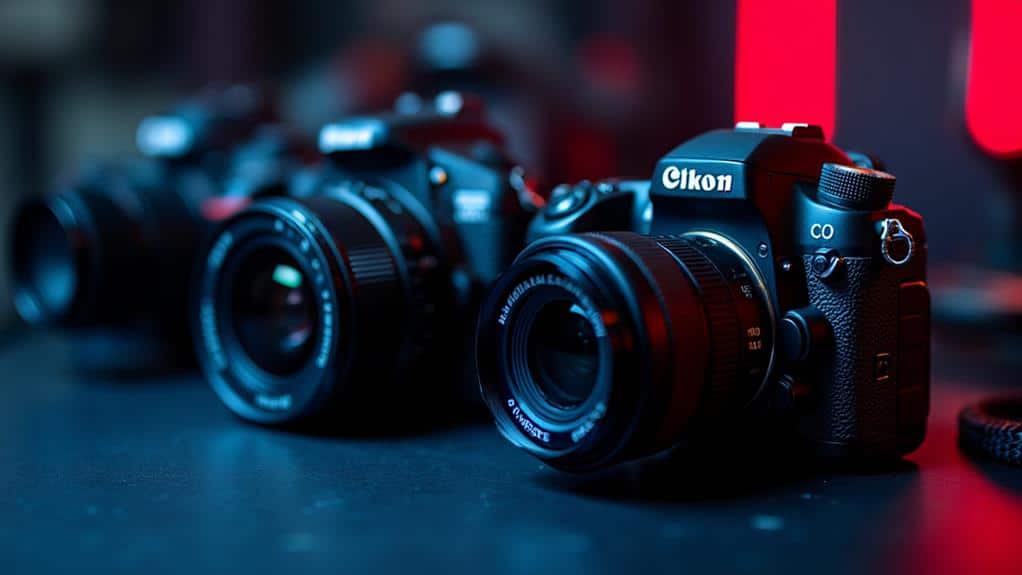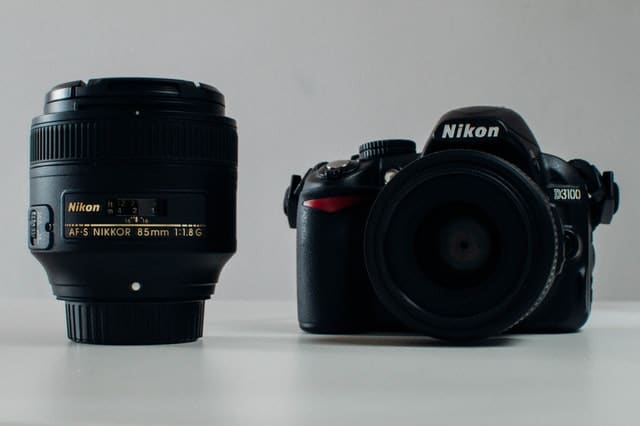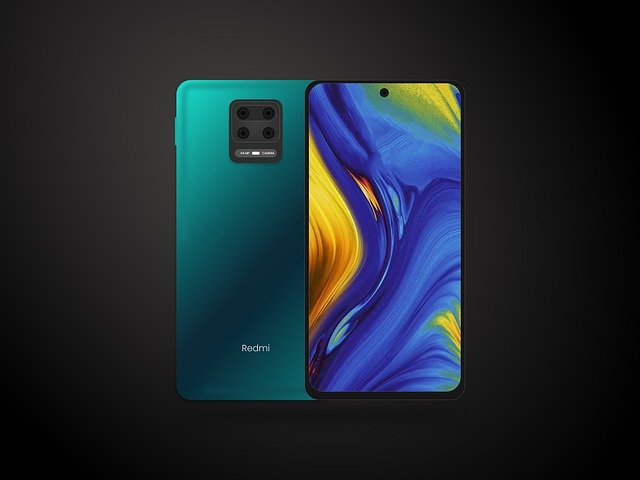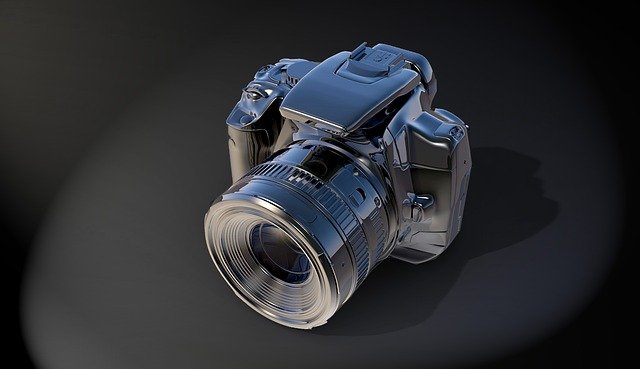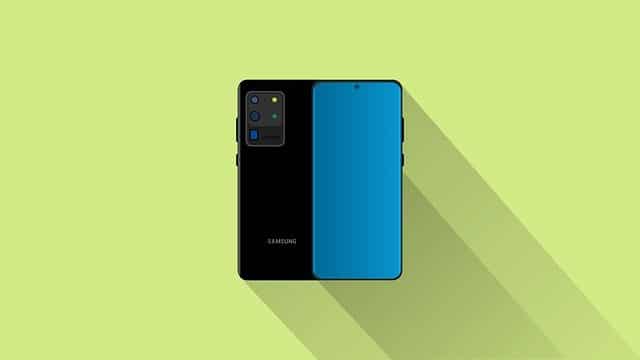If you're in search of a DSLR camera that excels in low-light conditions, three models stand out in 2024: the Pentax K-50, Nikon Df, and Canon EOS Rebel T4i. Each camera brings unique strengths to the table, whether it's the Pentax K-50's impressive ISO range of 51200 or the Nikon Df's advanced CMOS FX-format sensor. You'll also find the Canon EOS Rebel T4i offers exceptional performance thanks to its DIGIC 5 Image Processor. Wondering which one suits your needs best? Let's explore the intricate details and characteristics that set these cameras apart in challenging lighting environments.
Key Takeaways
- The Nikon Df excels with its FX-format 16.2 MP sensor and ISO up to 204800, ensuring top-tier low-light performance.
- Canon EOS Rebel T4i's 18 MP CMOS sensor and DIGIC 5 processor offer an ISO range up to 25600, perfect for low-light shooting.
- The Pentax K-50's ISO capacity up to 51200, coupled with in-body shake reduction, maximizes image quality in dim environments.
- Sensor size, such as the APS-C in Pentax K-50 and FX-format in Nikon Df, significantly impacts low-light performance by reducing noise.
- High-performing autofocus systems with advanced modules, like the 39-point in the Nikon Df, enhance clarity and sharpness in low light.
Pentax K-50 16MP Digital SLR Camera with 3-Inch LCD – Body Only (Black)
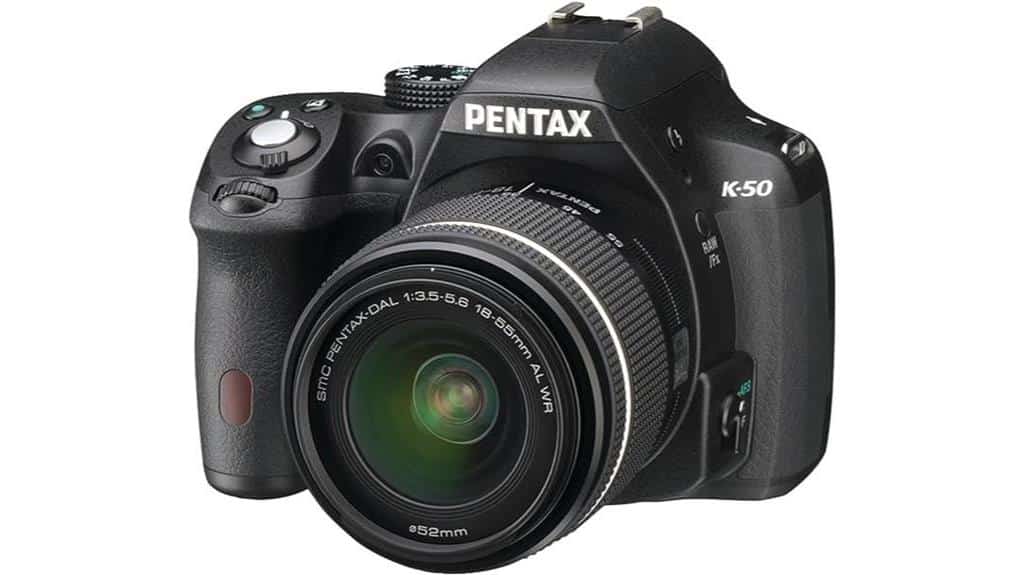
If you're looking for a DSLR that's made to excel in low-light conditions, the Pentax K-50 16MP Digital SLR Camera with 3-Inch LCD – Body Only (Black) should be on your radar.
Its 16 MP APS-C CMOS sensor and ISO speeds up to 51200 guarantee you capture stunning images even in challenging lighting.
The in-body Shake Reduction (SR) mechanism stabilizes each shot, minimizing blur.
You'll appreciate the intuitive controls and dual control dials, making quick adjustments easy.
The weather-sealed design lets you shoot in various environments without worry.
Plus, it offers 1080p HD video recording at 30 FPS, and the advanced autofocus with AF Assist lamp excels in low light.
With Eye-Fi compatibility for wireless transfers, it's versatile and efficient.
Best For: Photographers seeking a reliable, weather-sealed DSLR with excellent low-light performance and user-friendly controls.
Pros:
- High ISO speed up to 51200 for outstanding low-light performance
- In-body Shake Reduction (SR) mechanism for image stabilization
- Weather-sealed design for versatile shooting environments
Cons:
- Body only, requires separate lens purchase
- 16 MP resolution may be lower compared to newer models
- Limited to 1080p video recording at 30 FPS, not 4K
Nikon Df Digital SLR Camera with 50mm Lens
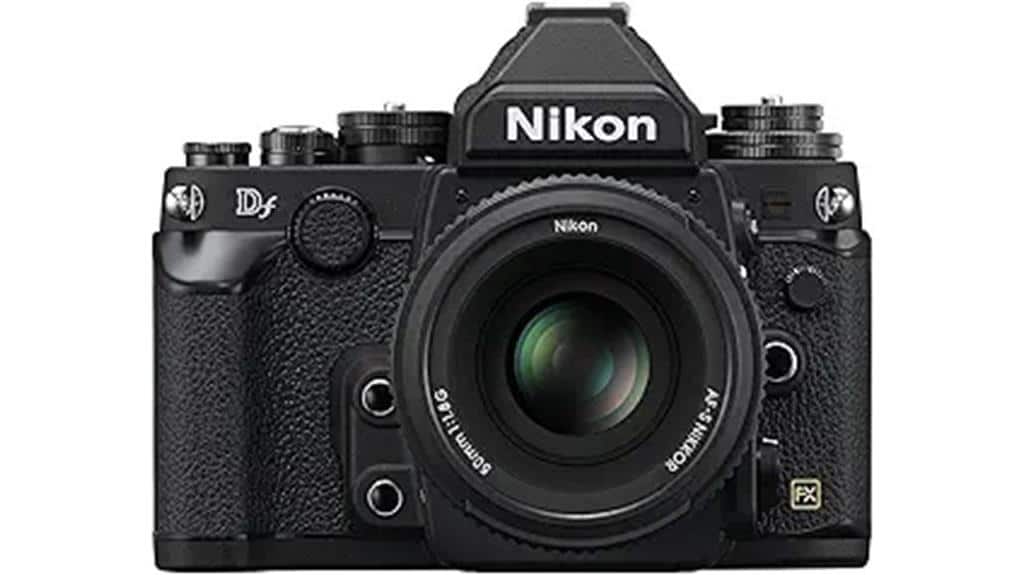
Nikon's Df Digital SLR Camera with the 50mm lens is a prime choice for photographers who demand exceptional low-light performance.
Equipped with a 16.2 MP CMOS FX-format sensor and EXPEED 3 processing, you'll capture stunning photos even in dim conditions. The ISO range of 100-12800 (expandable to 50-204800) guarantees you won't miss any detail.
With a 5.5 frames per second continuous shooting and a 39-point autofocus system, you stay sharp and fast.
The mechanical dials give a classic feel, while the rugged magnesium alloy body adds durability. Plus, you're set for versatility with compatibility for a wide range of lenses.
Don't forget, the optional WU-1a adapter makes sharing your masterpieces easy with instant Wi-Fi connectivity.
Best For: Photographers who demand exceptional low-light performance and enjoy a classic, mechanical feel with modern digital capabilities.
Pros:
- Excellent low-light performance with ISO range of 100-12800 (expandable to 50-204800).
- Versatile lens compatibility, supporting all current AF-S, AF-D, and AF NIKKOR lenses.
- Rugged and lightweight magnesium alloy body with elegant mechanical operation.
Cons:
- Optional WU-1a Wireless Mobile Adapter is needed for Wi-Fi connectivity.
- Continuous shooting speed of 5.5 frames per second might not be sufficient for high-speed action photography.
- Limited autofocus points compared to other high-end DSLR cameras.
Canon EOS Rebel T4i Digital Camera (Body Only)
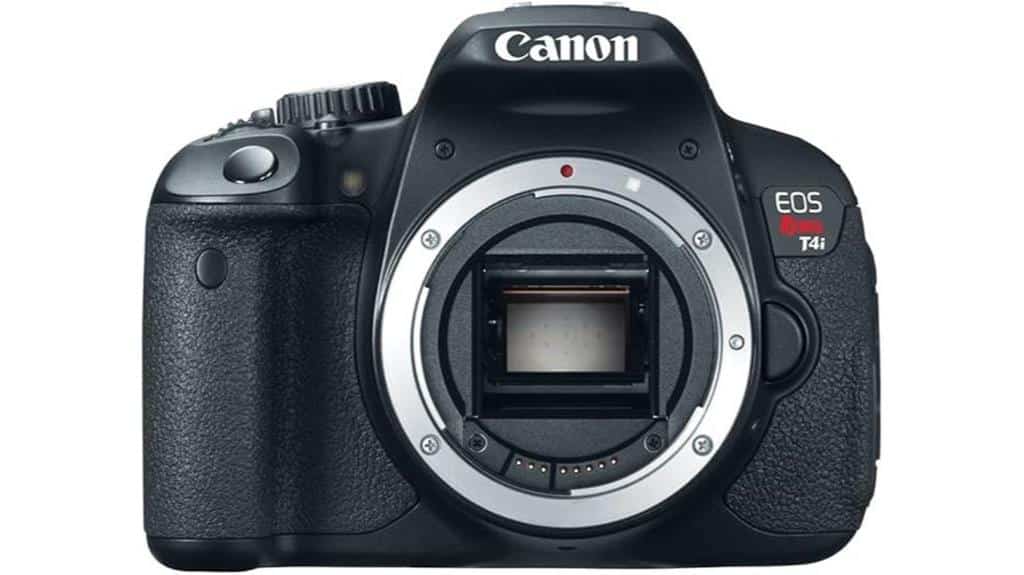
For photographers seeking top-tier low-light ISO performance, the Canon EOS Rebel T4i Digital Camera (Body Only) is an excellent choice.
It features an 18.0 Megapixel CMOS sensor and DIGIC 5 Image Processor, offering an ISO range of 100-12800, expandable to 25600 in H mode. You'll appreciate its high-speed continuous shooting up to 5.0 fps and the 9-point all cross-type AF system, including a high-precision dual-cross f/2.8 center point for sharp focus.
Moreover, the Rebel T4i excels in video with its EOS Full HD Movie Mode, built-in stereo microphone, and manual audio level adjustment.
Its 3.0-inch Vari-angle Touch Screen LCD monitor offers easy navigation and fine detail. Additionally, scene modes like Handheld Night Scene help capture stunning nightscapes effortlessly.
Best For: Photographers seeking a versatile camera with excellent low-light performance and advanced video features.
Pros:
- High-quality 18.0 Megapixel CMOS sensor with DIGIC 5 Image Processor
- Versatile shooting with high-speed continuous shooting up to 5.0 fps and a 9-point all cross-type AF system
- Enhanced video features including Full HD Movie Mode and a built-in stereo microphone
Cons:
- Body only, requiring the purchase of separate lenses
- Limited to shooting at up to 5.0 fps, potentially insufficient for some high-speed action photography needs
- Lacks built-in Wi-Fi, which may hinder immediate sharing and remote shooting capabilities
Factors to Consider When Choosing DSLRs for Exceptional Low-Light ISO Performance
When choosing a DSLR for elite low-light ISO performance, you should focus on several key factors.
Pay attention to sensor size, ISO range limits, and noise reduction techniques, as these directly affect image quality in dark conditions.
Also, consider the role of the image processor and autofocus performance to guarantee sharp, detailed shots no matter the lighting.
Sensor Size Impact
A key factor you need to ponder when choosing a DSLR for exceptional low-light ISO performance is the sensor size.
Larger sensor sizes allow for larger pixels, which can capture more light and reduce noise, substantially enhancing your camera's ability to perform well in low-light conditions.
When comparing sensor sizes, you'll find that full-frame sensors generally outperform APS-C sensors.
Their larger size enables them to house bigger pixels, which translates to better light-gathering capabilities and, consequently, superior low-light ISO performance.
This means you'll get clearer, brighter photos with less noise even in dimly lit environments.
The size of the sensor is vital not just for light capture but also for other aspects like the depth of field.
Larger sensors, such as full-frame ones, provide a shallower depth of field, giving your images a more cinematic look.
If you're aiming for good low-light ISO performance, aim for at least an APS-C sensor.
However, for the best results, a full-frame sensor is your ideal choice.
ISO Range Limits
Choosing the right ISO range limits can dramatically impact your DSLR's performance in low-light environments. A camera's ISO range limit is the highest setting at which it can capture an image with acceptable noise levels and dynamic range.
Higher limits generally indicate better low-light performance, but don't be fooled into thinking that bigger numbers are always better.
ISO range limits can vary greatly between models, with some offering as low as 6400 and others soaring to 204800.
While these high limits sound impressive, remember that other factors, like sensor size, lens quality, and image processing algorithms, also play vital roles.
For instance, a camera might boast an ISO 204800 limit, yet if its sensor and processing aren't up to par, your images could be plagued with noise and poor color accuracy.
Additionally, cameras with higher ISO range limits can sometimes exhibit more noise and color casts at lower ISO settings.
It's essential to evaluate the entire ISO range rather than just the top end.
Manufacturers usually specify the ISO range based on the camera's use case, target market, and the competition, so consider your specific needs when making a decision.
Noise Reduction Techniques
Considering DSLRs for exceptional low-light ISO performance means examining their noise reduction techniques closely.
Noise reduction in DSLRs involves sophisticated in-camera processing algorithms that detect and eliminate random pixels appearing as noise in your low-light images.
One effective technique is dark frame subtraction, where the camera captures a second exposure with the shutter closed, identifying the noise pattern and subtracting it from your original shot. This process can substantially reduce unwanted noise, enhancing image clarity.
Another efficient method is using noise reduction filters that selectively blur or smooth out noise while preserving vital image details.
This technique helps maintain the integrity of your photos without making them appear overly processed. Furthermore, some cameras implement multi-shot noise reduction, taking multiple exposures of the same scene and combining them to minimize noise.
This can be especially useful in static scenes where motion isn't a concern.
Additionally, look for DSLRs offering manual noise reduction controls.
These allow you to adjust the noise reduction level to your taste, giving you control over how much noise is reduced and how much detail is preserved.
This flexibility can be invaluable in achieving the desired balance between clarity and noise.
Image Processor Role
When selecting a DSLR for superior low-light ISO performance, the image processor's role can't be overstated.
It rapidly processes large amounts of data, minimizing noise and artifacts that can spoil your photos. A faster processor, like Canon's DIGIC 5, excels at handling high ISO speeds, allowing you to capture cleaner and more detailed images in challenging lighting conditions.
The image processor's bit depth, whether 14-bit or 16-bit, is vital as well.
It determines the camera's ability to capture a wider dynamic range, resulting in more accurate colors and better detail retention in low light. This means your images will have richer tones and finer nuances, making your night shots look stunning.
Moreover, the processor's speed and efficiency play a significant role in the camera's burst mode and video recording capabilities.
In low light, a quick image processor guarantees that your camera can maintain high performance, allowing you to shoot continuous frames or record videos without lag or degradation in quality.
In essence, don't underestimate the importance of a robust image processor.
It can make all the difference in achieving exceptional low-light ISO performance, enabling you to capture those perfect, well-lit shots even when natural light is scarce.
Autofocus Performance
While a robust image processor is vital for low-light ISO performance, autofocus (AF) accuracy can't be overlooked.
In dim conditions, a fast and accurate AF system is essential. Many DSLRs feature advanced modules with multiple cross-type points, which improve AF accuracy and speed.
More points and wider distribution across the frame can significantly enhance low-light performance, ensuring your subject is sharply in focus regardless of its position.
Phase-detection autofocus, commonly used in DSLRs, often struggles in low light. Mirrorless cameras usually use contrast-detection autofocus, which can perform better in such scenarios.
However, some DSLRs adapt by incorporating autofocus assist lamps, like the one in the Pentax K-50, to boost AF capabilities in near-darkness.
To further improve AF in challenging lighting, some DSLRs offer specialized low-light modes.
For example, Canon's EOS Rebel T4i includes a Handheld Night Scene mode, enhancing focus accuracy in tough conditions.
When choosing a DSLR for exceptional low-light performance, consider models with robust AF features, including multiple AF points, assist lamps, and specialized modes, ensuring reliable and sharp focus even in the darkest environments.
Lens Compatibility Importance
To get the best low-light ISO performance from your DSLR, lens compatibility is key. The right lens can dramatically influence how much light enters your camera, enabling better light transmission and less noise, essential for capturing stunning photos in dim conditions.
Firstly, consider the lens mount type. Different DSLRs come with specific lens mounts, and ensuring you have a wide selection of compatible lenses can make or break your low-light shooting experience.
Not all lenses are created equal, so having access to a variety of high-quality options is vital.
Next, look for lenses with features like image stabilization and wide apertures. An image-stabilized lens helps you shoot handheld in low light without introducing blur, while a wide aperture allows more light to hit the sensor, improving performance immeasurably.
Additionally, quieter internal focusing motors can be a game-changer. They reduce camera noise and vibration, pivotal in low-light conditions where every detail matters.
Lastly, your lens's impact on autofocus performance is significant in low light. Compatible lenses often enable faster, more precise focusing, ensuring you don't miss those fleeting moments.
Build Quality Factors
Choosing a DSLR for exceptional low-light ISO performance often depends substantially on its build quality.
You need to ponder a weather-sealed camera body with rubber port covers and a handgrip. These features help protect your device from moisture and dust, ensuring it performs reliably in challenging, low-light conditions.
A magnesium alloy body offers added durability and resistance to wear and tear, essential if you frequently use your DSLR in demanding environments.
This type of construction provides robustness, allowing your camera to withstand harsh conditions without compromising on performance.
Ergonomics are equally important.
The shape and size of the grip can impact your ability to hold and operate the camera comfortably in low-light situations.
A well-designed grip makes it easier to handle prolonged shooting sessions without fatigue.
The materials used in construction, whether metal or plastic, affect the overall build quality.
Metal bodies generally offer more resilience, while plastic might feel less sturdy but can be lighter.
At a Glance
When you're choosing a DSLR for exceptional low-light ISO performance in 2024, you can't go wrong with the Pentax K-50, Nikon Df, or Canon EOS Rebel T4i. The Pentax K-50 offers a stellar ISO range, the Nikon Df excels with its FX-format sensor and advanced processing, and the Canon EOS Rebel T4i delivers with its high-resolution sensor and DIGIC 5 Image Processor. Keep these options in mind, and you'll be capturing stunning low-light photos in no time!

